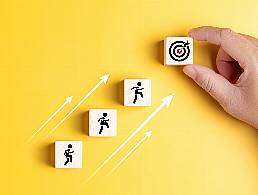How you get up in the morning is crucial to how the rest of your day could go. What if you could retrain yourself to have a better morning routine? Ben Butler has some advice.
Mark Twain wrote that you should start every morning by eating a frog, so that the rest of the day would seem like a breeze in comparison. Or, if a breeze is really what you’re looking for, you could follow Churchill’s regime of an ‘air bath’ : lounging around in the nip for an hour every morning.
Famous people throughout history have had countless variations on the ‘ideal’ morning routine. For most of us, however, a successful morning is more about just getting out of bed and making it into work. But what if I told you that you could get more out of your mornings, feel better throughout the day, and all with less effort?
I really realised the importance of morning routines thanks to Tim Ferriss’ podcast. Ferriss asks every guest what the first 60 to 90 minutes of their day looks like, and, although each person’s routine was relatively idiosyncratic, there were some commonalities. First, the fact that they actually had a morning routine, but things like journaling, meditation, exercise and a proper breakfast kept cropping up.
My morning routine was pretty terrible. Every morning, I’d wake up, I’d roll over, pick up my phone and comb through each of my newsfeeds, dissecting the fake, filtered lives of others.
Then, with my happiness determined somewhat by the algorithms of my social media, I’d eventually stumble out of bed, grumble around as I threw on clothes and stuff whatever food I had into me, and plod into work.
We’re going to take a look at how I’ve tried to build a better morning for myself, but let’s first take a look at our brain, and how it works.
The brain as two systems
You might know the story of the tortoise and the hare, one of Aesop’s Fables. The story concerns a speedy hare who constantly ridicules a slow-moving tortoise. One day, the tortoise has had enough and challenges the hare to a race. The hare gets to a point where he’s so confident of winning that he takes a nap in the middle of the race. When the hare wakes up, however, he finds that the tortoise, crawling slowly but steadily, has passed him out and won the race.
It’s a good story, and we can use this fable to understand how our brains work. We can think of our brain as having two systems: fast and slow, hare and tortoise.
Let’s start with the tortoise, our ‘slow’ or deliberate brain. The slowness here is in reference to the system that controls conscious, careful behaviour. The slow brain is logical, reflective and capable of handling complex problems.
But it has limited capacity because it relies heavily on working memory and it’s a tight squeeze in there. How tight? Well, recent research suggests we can only hold a maximum of three or four things in it at one time – so think of a sticky note.
Our tortoise brain is compensated by our ‘fast’ brain, the hare. Our fast brain automates the majority of what we do on a daily basis, and removes the need for us to consciously focus on every little thing. For most things in life, we want to be thinking at the speed of hare, not the speed of tortoise.
So, the objective of a routine is to move conscious activity in our tortoise brain into automatic ‘hare brain’ processes. That can be tough though, right? The sort of thing usually reserved for incredible people, with super strong willpower? But I don’t believe that’s true.
Building willpower
We tend to think of willpower as a character trait, a trait that – although varying among different people – remains pretty constant at the individual level. But that’s not the case. You can train your willpower like a muscle. And, again like a muscle, your willpower can get tired. Constant decision-making overtires your tortoise brain, leading to decision fatigue.
Decision fatigue describes a phenomenon known as ego depletion: we have a finite store of mental energy for exerting self-control. Ego depletion is the reason you stick rigidly to your diet all day, and then have six Snickers when you get home.
It’s the reason you stay calm under pressure all day in work, and then flip out at a friend over something trivial. The way to counter it or to reduce conscious, tortoise-style, decision fatigue is to automate regular activities , like what you wear.
When I first came across this concept, I went all out – full Zuckerberg. I had a self-imposed uniform of white shirt, dark jeans, navy New Balance. I was getting up at the same time every day, doing the same workout, having the exact same thing for breakfast, taking the same route to work. That’s the thing about ego depletion – the fix isn’t to do less things, it’s setting up your life so that you make less decisions.
‘I’m not getting up to do 10-mile runs and squeeze pomegranate juice, or whatever it is that successful people do in the mornings – but I do get set up well for the day ahead’
— BEN BUTLER
In fact, you often end up squeezing more into your mornings because it’s all on automatic processing , not requiring conscious brain activity. And it was great, for a while, but it’s deceivingly easy to do that when your life is in a vacuum. At the time, I was leading some projects in work, as well as preparing for a TEDx talk. My life was pretty focused: work and prep.
It’s a whole different ball game when you start introducing variables. Throw in things like children, partners and other commitments, and I can see how the idea of a routine like this can seem impossible. It’s certainly impossible to do every day, but it’s definitely possible to incorporate some elements of it.
For me, I didn’t have kids or anything but I began travelling more, both for work and for pleasure. I was also doing more with my evenings; going to gigs, or for dinner and drinks with friends. The combination of jet lag, location changes and late nights wreaked havoc on my ‘perfect morning’. Then again, they were some of the best weeks of my life.
Back to basics
These days, as I get back into a routine in Dublin, I’m trying to build up my morning routine again. With the routine, I have a lot more going on in the mornings, but it’s all automatic processing. Don’t get me wrong, I’m not getting up to do 10-mile runs and squeeze pomegranate juice, or whatever it is that successful people do in the mornings – but I do get set up well for the day ahead.
The trick I’ve found is using a ‘when-then’ plan, which states that ‘when X happens, then I will do Y’. It’s known more formally as an ‘implementation intention’, but I like ‘when-then’ because it rhymes.
It’s been shown in more than 200 studies that such plans make it three times more likely to achieve what you set out to do. It works well because it removes the decision fatigue of our conscious brains having to think about what do next – each action has its following action lined up.
As an example, here’s my when-then plan for an ideal morning: when I wake up, I will immediately head to the bathroom to wash up. When I head back to my room, then I will do a ConBody Live workout. When I finish my workout, then I will make breakfast. When I’m eating my breakfast, I’ll read an article in The New Yorker, then I’ll start journaling. When I’m done journaling, then I’ll shower, get changed and head out the door.
Two notes here. One: this is my ‘ideal’ morning; I’m definitely not hitting all of this every day. Two: this is my ideal morning. Yours might and should look totally different. I’d recommend that you think about what’s important to you or what makes you happy.
As an example, meditating is becoming more and more popular with apps like Headspace. I personally find meditating super difficult, particularly in the morning, but it could work for you.
The ideal takeaway here isn’t that you copy my – or anyone’s – morning routine. Rather, it’s that you think about your morning, and try and build up to a routine that works for you. And don’t worry about trying to get it perfect. As Oscar Wilde once put it: “Only dull people are brilliant at breakfast.”
You definitely don’t have to be brilliant – just aim for better.
By Ben Butler
Ben Butler is a former Trinity College Dublin Business Student of the Year and National Student Entrepreneur 2015 Winner. Butler now focuses on speaking, writing and trying to keep up with his weekly subscription to The New Yorker.




